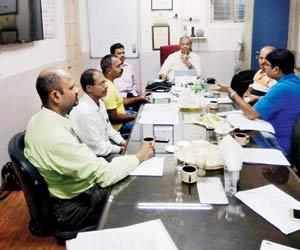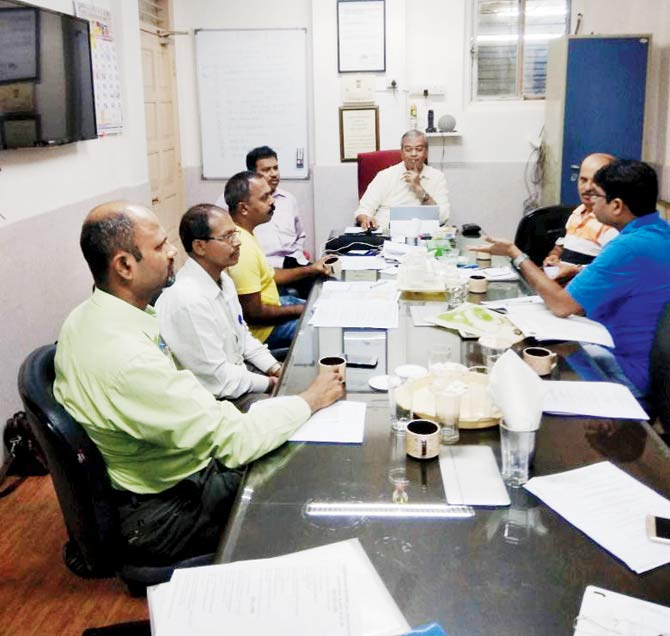Alarmed by the shutting down of 1,300 Marathi schools across Maharashtra in recent years, parents and teachers are devising innovative teaching and learning methods

The closure of 1,300 Marathi-medium schools across the state has caused much alarm among parents and teachers. The decision by the state, due to "very less" patronage, has raised fears of the language dying. A city school has, hence, jumped in to revive Marathi with the help of Marathi Abhyaas Kendra - parents and teachers from Marathi-medium schools will come together, design a plan on innovative teaching methods, and submit it to the state.
ADVERTISEMENT

A meeting that was held at D S High School in Sion to discuss the convention, scheduled for December 23-24
D S High School in Sion, a Marathi-medium school that is spearheading the initiative, has itself introduced several innovative teaching and learning methods to stay on par with reputed English-medium schools. It will hold a convention on December 23 and 24 to brainstorm for ideas on how to revive the mother tongue and such schools, considering more parents prefer English medium these days.
Representatives of 10 schools from across Maharashtra that have implemented new ways to make teaching more effective will be brought to the city to showcase their ways. Experts will also be called in to emphasise on the importance of basic education in the mother tongue. Talks will be held with parents to understand their changing preferences. After taking all of this into account, a proposal will be prepared and sent to the government.
Keeping pace
Rajendra Pradhan, trustee president of D S High School, said, "It is unbelievable that in the online process for those who wish to apply for opening a new school in Maharashtra, the option of Marathi doesn't exist in the list of mediums - it's only English, Hindi and Urdu. While the government has already stopped the scope for new Marathi-medium schools to come up, it has not even taken any proactive steps to help the existing ones to sustain. It's a sad state of affairs for the mother tongue in its own land."
The 80-year-old school was the first to start Spoken English classes from Std I. It trained its teachers first before starting lessons for the students. "English was introduced in all Marathi schools from 2000, but what matters is how it is taught. And we have shown the difference effective teaching can make. Like us, there are other schools that have introduced innovative methods to keep pace with New Age requirements. Instead of blaming the government completely, it's important that Marathi schools themselves take such steps," he added.
Giving it a spin
The group working on this initiative plans to adopt 200 Marathi-medium schools across the state to implement changes and experimental and progressive methods of teaching. Coordinator of the Marathi Abhyaas Kendra Anand Bhandare said, "In most countries, education in mother tongue is a norm. Also, it's been proven time and again, with several research papers by reputed organisations UNICEF, UNESCO and others, that elementary education in a child's mother tongue is the most effective way of learning. But in India, the picture is completely different, especially in Maharashtra - forget urban localities; here, even in rural areas, craze for English-medium schools is on the rise. "While we can't completely negate the parents' point of view, it's time Marathi-medium education took that long-pending spin in the way teaching and learning is done in order to make its students ready for the world."
Changing times
While several parents have lauded the initiative, many have said times are changing and they with it. "In today's world, even a taxi or rickshaw driver feels that his/her child should go to an English-medium school. A child can't be taught science in Marathi medium and then be left to deal with the shock of answering the same in English during medical or engineering entrance tests. Regional medium students do tend to lag behind, and no parent wants that.
So, what English-medium schools can do is offer Marathi language on the same level at which it is taught in Marathi-medium schools. That way, students won't lose touch with their mother tongue while learning other concepts in English to survive in this competitive world," said Ajay Kulkarni, a civil engineer who studied in a Marathi-medium school but preferred English medium for his daughter.
Download the new mid-day Android and iOS apps to get updates on all the latest and trending stories on the go
 Subscribe today by clicking the link and stay updated with the latest news!" Click here!
Subscribe today by clicking the link and stay updated with the latest news!" Click here!






